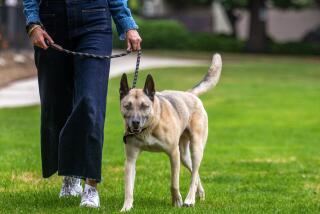Dogs Are Not Vicious Fighters, Club Members Insist : Owners Try to Soften Image of Pit Bulls
- Share via
For the pit bulls, the haul was only 15 feet. For their owners, it has been considerably longer, and it’s not over yet, not by a long shot.
Since 1977 the American Pit Bull Terrier Club of Southern California has been waging war against pit bull owners who match the animals in fights, and against the popular image of the dog as a vicious, lethal weapon bred to fight to the death.
Owners who raise dogs for fighting are barred from membership, and any members discovered to have been associated with dog fights or even facing dogs off in a test are kicked out with no possibility of reinstatement.
“These dogs can be trained not to react in that way,” said club member Pat Goodman. “A dog will do anything to please its owner. A responsible owner is in total control of his dog.”
At one of the club’s twice-monthly shows recently in South El Monte, one event was a weight pull, “simply a show of strength” for the athletic dogs, Goodman said. Dogs were divided into seven weight classes ranging from 26 pounds to over 85 pounds, and each animal had to pull a 100-pound cart plus a weight of at least 50 pounds for 15 feet.
Strapped into harnesses attached to the carts, the pit bulls jumped and strained against the load to reach their owners who held a “bait”--often their favorite toys. Baits must be inanimate objects--a basketball, brooms, towels, even a motorcycle tire. Some dogs, however, have been trained to pull on a simple verbal command.
When the grunting and groaning was over, Aki Oni, owned by Lloyd Drain and Jill Schuster of Garden Grove, pulled the most weight--1,050 pounds.
About 50,000 pit bulls are registered annually in this country by the United Kennel Club alone, Goodman said. Shows have improved the increasingly popular breed’s image, she added, and children played and handled many of the dogs in the recent competition.
“Once people get a pit bull, they realize what terrific family pets they are,” Goodman said. “They’re one of the few breeds I really trust with children.”
Several cities, however, don’t trust them with anyone, and Santa Monica has adopted an ordinance requiring pit bulls to be muzzled when they are on public streets.
The club’s 100 members bristle at such restrictions, and statistics from Los Angeles’ Animal Regulation Department show only a slight difference in the frequency of pit bulls and German shepherds biting people.
The department has recorded 68 dog bite cases from the 3,743 pit bulls in its files, or 1.8%. The 35,811 German shepherds in its files are responsible for 410 bites, or 1.1%
“A pit bull is slightly more likely to bite a human being than a shepherd,” said Meyer Levine, an administrative assistant with the department, adding that the difference is “statistically insignificant.”
“Dogs aren’t born to be killers, but any dog can be trained to kill,” Levine said. “Pit bulls have extraordinarily powerful jaws. Our animal control officers say a pit bull could probably bite the arm off a man.”
A pit bull’s bite exerts an estimated 1,500 pounds of pressure per square inch--nearly twice the force of a German shepherd’s bite.
“So many cities are trying to outlaw these dogs,” Goodman said. “You don’t get rid of crime by getting rid of the victim. You have to get rid of the criminal, and that’s the irresponsible dog owner. That goes for any breed.”
Known by 2 Names
Depending on who registers them, pit bulls are known by two names in this country: American Staffordshire terriers if they are registered by the American Kennel Club, and American pit bull terriers when they are registered by the United Kennel Club.
Although their distant ancestors are traced to 18th-Century England when dog fighting was a common and legal pastime, the breed as it is known today has almost purely American origins.
By the early 1900s, pit bulls and the practice of fighting them had become popular in this country. At about the same time, a smaller version of the American pit bull terrier, the Staffordshire bull terrier, was developed in England and is also popular in this country.
It may come as a surprise to generations of Americans who grew up on “Our Gang” comedies to learn that Petie, the hapless pooch with a black ring around one eye, was a pit bull.
Times Have Changed
But Petie’s gentleness, as an indicator of the breed’s temperament, was lost even on dog show sponsors. Eight years ago, Goodman said, she could never take her dogs to a show and identify them as pit bulls.
“We would have been asked to leave the ground,” she said. “Now we can go to any show. We have educated the dog people. That was the first step. Now we have to get the rest of the public.”
More to Read
Sign up for Essential California
The most important California stories and recommendations in your inbox every morning.
You may occasionally receive promotional content from the Los Angeles Times.













